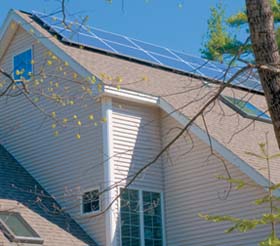 |
 |
| current issue |  | past issues |  | send a letter/news |  | address update |  | advertise |  | about us |  | alumni home |
Alumni Profiles
|
Pay It Forward Many hands make light work—and cheaper solar power By Crystal Ward Kent '78 |
Easy to print version |
 Ann Bliss '80G, right, with Dwight and Barbara Baldwin of Durham, whose house now has photovoltaic solar panels. |
They arrive at the house with toolboxes and determination, a small army whose mission is to convert sunlight into hot water or electricity. After a solid day's work, a new solar system is installed for a fraction of the usual price, thanks to many helping hands. They're members of SEAREI, the Seacoast Area Renewal Energy Initiative, and their goal is to make solar technology affordable for the average family.
The nonprofit organization is the brainchild of Ann Bliss '80G and her husband, Michael; Melinda Salazar '02G and Kevin Beane '77 are co-directors. Ann Bliss was inspired by a story in the Boston Globe about a Plymouth, N.H., organization, Plymouth Area Renewable Energy, which uses the old-time barn-raising concept. The Blisses volunteered at two Plymouth "energy raisers," and were so impressed they decided to establish a similar group. Since then, SEAREI has worked with local contractors and volunteer craftsmen to help local residents install three solar hot water systems and four photovoltaic systems (for electricity) in 2009, with more scheduled for 2010. The rule of thumb is that members volunteer at two energy raisers in order to have an energy raiser at their own house.
A psychotherapist in her day job, Ann Bliss is committed to SEAREI. "I've been involved with the Piscataqua Sustainability Initiative," she says. "I feel SEAREI is a natural offshoot of that. My husband and I are passionate about reducing the use of fossil fuels and our carbon footprint."
Michael and Rose Koutelis of Epping, N.H., had a solar thermal hot water system added to their home through an energy raiser. "They installed it in just six hours, and I'm very pleased with it," says Michael Koutelis. "I'm now learning about the solar photovoltaic system. Normally it would cost $18,000 to install, but with SEAREI and state and federal energy credits, it will only be about $6,500."

The Baldwins reported that they are "very happy with the solar PV system. It is working exactly as anticipated and I have enjoyed keeping track of the amount of electricity we generate. The 2.76 kilowatt system is designed to generate about 75 percent of what we consume in a year's time. We were most impressed by the expertise and kindness of the people/strangers who showed up to help us with the installation. It is a new twist on the "old helping neighbors concept." |
Kevin Gardner, a UNH professor of conservation and environmental engineering and chair of the Durham Energy Committee, also had a solar hot water heating system installed. "During the winter, I had an electric hot water heater as backup for cloudy days, but now that the sun is out more, all my hot water is powered by the sun," he says.
Bliss and SEAREI's directors have lots of plans for the future. "We want to increase our educational outreach," she says. "We plan to expand our energy share potlucks, where we have a speaker address key energy topics, such as energy legislation, tax incentives and other ways to increase efficiency. We also want to offer Weatherization Raisers, whereby volunteers work together to add weatherization to people's homes. And we hope to find a cost-effective way to offer energy audits. Learning where you can save energy and how your home may be losing energy is critical if you truly want to be energy efficient."
Easy to print versionblog comments powered by Disqus

